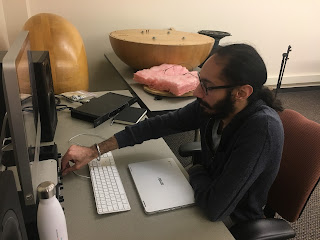CMI/IUPUI Speaker Restoration Project: Update I
This week we're going to give a quick update on how the speaker rehabilitation is going, starting with an introduction on the student in charge of the repairs.
 Keher Neote is a first-year returning Electrical Engineering student who's been building and repairing speakers for about three to four years. Though not quite an expert, he's definitely one of the more learned audiophiles on campus with an especially keen interest in speaker design. This is his fourth speaker restoration project to date (his first since starting at IUPUI last semester) and it has been proceeding as planned since the day we picked the speakers up back in January. His project goals include the following: analyzing the potential of each speaker, specifically its cabinet and driver, taking SPL (sound-pressure-level) measurements of each driver to decide how well these speakers perform compared to today's standards, presenting these findings to fellow speaker enthusiasts, and readying these speakers for performance at the end of the semester.
Keher Neote is a first-year returning Electrical Engineering student who's been building and repairing speakers for about three to four years. Though not quite an expert, he's definitely one of the more learned audiophiles on campus with an especially keen interest in speaker design. This is his fourth speaker restoration project to date (his first since starting at IUPUI last semester) and it has been proceeding as planned since the day we picked the speakers up back in January. His project goals include the following: analyzing the potential of each speaker, specifically its cabinet and driver, taking SPL (sound-pressure-level) measurements of each driver to decide how well these speakers perform compared to today's standards, presenting these findings to fellow speaker enthusiasts, and readying these speakers for performance at the end of the semester.
After digging into the actual drivers and electrical components of each speaker, it was revealed that one of them still worked relatively well. Music sent through it via audio interface produced a clear, though slightly distorted, sound, and the cone and tweeter still functioned as designed. The other driver, however, was not so lucky, and seems to be in an unusable state of disrepair. Because repairing the actual driver is beyond the scope of this project, mostly due to the complex, coaxial nature of the driver itself as well as the age of the materials, Keher decided that he would use the single, working driver in all of his performance tests of the speakers.
 True measurements of a speaker's SPL would require having them be taken in an anechoic chamber, a room that has no reverberation as well as no outside noise. Without the interfering frequencies, the only sound entering a microphone recording the sound is coming from the speaker, serving as a true gauge of the speaker's performance. Keher contacted Klipsch Audio, a loudspeaker company based on the northern side of Indianapolis, in hopes of being able to request use of their anechoic chamber. Fortunately, the engineers there were very enthusiastic about helping out on this project, and we're currently preparing the speakers for transport to their facility in order to conduct the tests. Why both speakers, if there is only one working driver? Unlike the speaker cabinets themselves, the drivers between the two are very similar, so that the one driver can actually be placed in either speaker cabinet and still function. This modular aspect of the speaker design suggests the original purpose of these cabinets being mostly experimental, to test whether the speaker cabinet shape is worth the extra effort to manufacture. Keher's original plan is to take both cabinets into the anechoic chamber and trading the driver between the two to check both cabinets. Whether this is possible or not depends on the kind of van we can get to carry them (if you have a large vehicle, let us know!).
True measurements of a speaker's SPL would require having them be taken in an anechoic chamber, a room that has no reverberation as well as no outside noise. Without the interfering frequencies, the only sound entering a microphone recording the sound is coming from the speaker, serving as a true gauge of the speaker's performance. Keher contacted Klipsch Audio, a loudspeaker company based on the northern side of Indianapolis, in hopes of being able to request use of their anechoic chamber. Fortunately, the engineers there were very enthusiastic about helping out on this project, and we're currently preparing the speakers for transport to their facility in order to conduct the tests. Why both speakers, if there is only one working driver? Unlike the speaker cabinets themselves, the drivers between the two are very similar, so that the one driver can actually be placed in either speaker cabinet and still function. This modular aspect of the speaker design suggests the original purpose of these cabinets being mostly experimental, to test whether the speaker cabinet shape is worth the extra effort to manufacture. Keher's original plan is to take both cabinets into the anechoic chamber and trading the driver between the two to check both cabinets. Whether this is possible or not depends on the kind of van we can get to carry them (if you have a large vehicle, let us know!).
That concludes our update on the technical side of our project. Next week, we'll take a peek on what our performers are working on musically. Look forward to it!
-Kat
Image of anechoic chamber courtesy of http://antennatestlab.com/antenna-education-tutorials/what-is-an-anechoic-chamber


Comments
Post a Comment